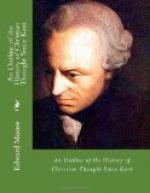The period from 1820 to 1850 was one of religious and intellectual activity in Scotland as well. Tulloch depicts with a Scotsman’s patriotism the movement which centres about the names of Erskine and Campbell. Pfleiderer also judges that their contribution was as significant as any made to dogmatic theology in Great Britain in the nineteenth century. They achieved the same reconstruction of the doctrine of salvation which had been effected by Kant and Schleiermacher. At their hands the doctrine was rescued from that forensic externality into which Calvinism had degenerated. It was given again its quality of ethical inwardness, and based directly upon religious experience. High Lutheranism had issued in the same externality in Germany before Kant and Schleiermacher, and the New England theology before Channing and Bushnell. The merits of Christ achieved an external salvation, of which a man became participant practically upon condition of assent to certain propositions. Similarly, in the Catholic revival, salvation was conceived as an external and future good, of which a man became participant through the sacraments applied to him by priests in apostolical succession. In point of externality there was not much to choose between views which were felt to be radically opposed the one to the other.
Erskine was not a man theologically educated. He led a peculiarly secluded life. He was an advocate by profession, but, withdrawing from that career, virtually gave himself up to meditation. Campbell was a minister of the Established Church of Scotland in a remote village, Row, upon the Gare Loch. When he was convicted of heresy and driven from the ministry, he also devoted himself to study and authorship. Both men seem to have come to their results largely from the application of their own sound religious sense to the Scriptures. That the Scottish Church should have rejected the truth for which these men contended was the heaviest blow which it could have inflicted on itself. Thereby it arrested its own healthy development. It perpetuated its traditional view, somewhat as New England orthodoxy was given a new lease of life through the partisanship which the Unitarian schism engendered. The matter was not mended at the time of the great rupture of the Scottish Church in 1843. That body which broke away from the Establishment, and achieved a purely ecclesiastical control of its own clergy, won, indeed, by this means the name of the Free Church, though, in point of theological opinion, it was far from representing the more free and progressive element. Tulloch pays a beautiful tribute to the character of Erskine, whom he knew. Quiet, brooding, introspective, he read his Bible and his own soul, and with singular purity of intuition generalised from his own experience. Therewith is described, however, both the power and the limitation of his work. His first book was entitled Remarks on the Internal Evidence for the Truth of Revealed Religion, 1820. The title




